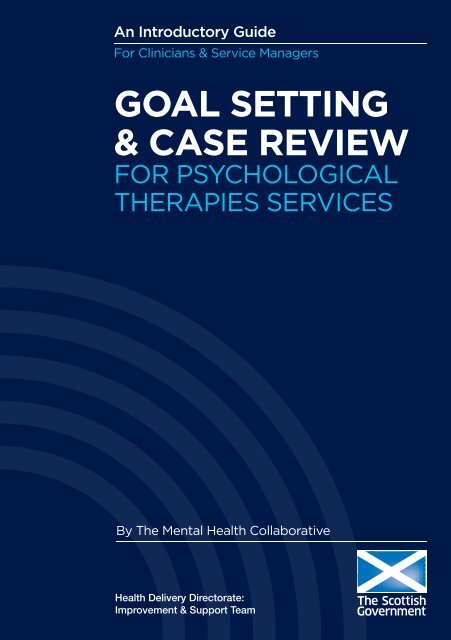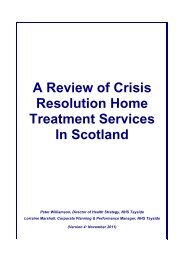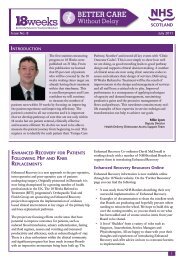Goal Setting & Case Review for Psychological Therapies Services
Goal Setting & Case Review for Psychological Therapies Services
Goal Setting & Case Review for Psychological Therapies Services
You also want an ePaper? Increase the reach of your titles
YUMPU automatically turns print PDFs into web optimized ePapers that Google loves.
An Introductory Guide<br />
For Clinicians & Service Managers<br />
GOAL SETTING<br />
& CASE REVIEW<br />
FOR PSYCHOLOGICAL<br />
THERAPIES SERVICES<br />
By The Mental Health Collaborative
01/02<br />
Introduction<br />
This guide provides a basic<br />
introduction to goal setting<br />
and case review. It is part of a<br />
series of introductory guides<br />
<strong>for</strong> psychological therapies<br />
services. These guides cover<br />
four areas: Demand, Capacity,<br />
<strong>Goal</strong> <strong>Setting</strong> & <strong>Case</strong> <strong>Review</strong><br />
and Clinical Administration.<br />
There is also an introductory<br />
guide called ‘Start Here’ that<br />
looks at how to implement<br />
change in the midst of<br />
uncertainty about what<br />
will work.
<strong>Goal</strong> setting and case review are crucial aspects<br />
of managing demand in psychological therapies<br />
services. In any service it is important to be clear<br />
about the goals of the intervention. They need<br />
to be achievable and should match as closely as<br />
possible both the identified needs of the patient<br />
and their expectations.<br />
Improving our ability to set appropriate treatment<br />
goals, building in case review, and reviewing<br />
existing case loads will notably improve the<br />
efficiency of our service and the treatment of our<br />
patients.<br />
Some may say that the goal setting approach only<br />
works with a CBT treatment model. Certainly, the<br />
method and language used fit well with a CBT<br />
model. But all therapeutic interventions could<br />
reasonably be expected to set clearly defined<br />
and measurable goals, albeit using a different<br />
framework or language.<br />
For the purposes of these guides, a <strong>Psychological</strong><br />
Therapy Service is any local service providing<br />
psychological therapies. Examples might include:<br />
Primary Care Mental Health Teams, Community<br />
Mental Health Teams, Clinical Psychology Service<br />
and <strong>Psychological</strong> <strong>Therapies</strong> <strong>Services</strong>.
03/04<br />
<strong>Goal</strong> <strong>Setting</strong><br />
It is not unusual <strong>for</strong> people to be referred <strong>for</strong><br />
psychological therapy when the identified need<br />
may not be best met by therapy. For example,<br />
someone whose psychological distress is the result<br />
of notable debt problems, may need help from a<br />
specialist debt advice service.<br />
Often people have high and unrealistic<br />
expectations of what can be achieved with<br />
psychological therapy. Understandable and normal<br />
reactions to events such as bereavement are<br />
not likely to need, or benefit from, psychological<br />
therapy. A person’s goal of not experiencing a<br />
feeling of loss would not match the likely outcome<br />
of psychological therapy.<br />
It is also important to consider the expectations of<br />
referrers and patients with respect to the goals of<br />
different levels of service. A brief guided-self help<br />
programme with a limit of three sessions, a stress<br />
control class of 4 sessions, six brief counselling<br />
sessions, and sixteen High Intensity CBT contacts<br />
would all have their own limits on what was<br />
achievable.<br />
“”<br />
Often people have high and<br />
unrealistic expectations of<br />
what can be achieved with<br />
psychological therapy
<strong>Case</strong> <strong>Review</strong><br />
Monitoring and reviewing cases is an important<br />
part of our work as psychological therapists.<br />
It allows us to monitor progress towards a good<br />
outcome and check that our input/competency<br />
matches the needs of the patient.<br />
In practice many clinicians, especially the less<br />
experienced, greatly appreciate the learning they<br />
gain from regular case review. For case review to<br />
be effective:<br />
• this process should be non-threatening,<br />
supportive and used to in<strong>for</strong>m both the individual<br />
and the service about clinical issues that arise;<br />
• occur in supervision, as well as <strong>for</strong>ming part of<br />
a psychological therapist’s individual reflective<br />
practice;<br />
• allow the recording of in<strong>for</strong>mation that will help<br />
planning of training.<br />
From the operational point of view, there is a<br />
need to monitor the demand generated by each<br />
case and to compare this with predicted demand.<br />
There is also a need to monitor fit with service/<br />
team criteria. Regular recording and collation of<br />
service use in<strong>for</strong>mation should be an integral part<br />
of the service manager’s role. The Demand <strong>for</strong><br />
<strong>Psychological</strong> <strong>Therapies</strong> <strong>Services</strong> guide provides<br />
further in<strong>for</strong>mation on this.
<strong>Goal</strong> <strong>Setting</strong><br />
SMART Clinical Work<br />
One way of considering clinical interventions is to<br />
be SMART. For each patient we can ask ourselves<br />
a number of questions about the goals of the<br />
intervention.<br />
S.M.A.R.T. stands <strong>for</strong><br />
S<br />
Treatment goals should be specific<br />
M<br />
Therapist and patient should be able to<br />
measure whether they are meeting their<br />
goals<br />
A<br />
Are the goals set, achievable and<br />
attainable<br />
R<br />
Can you realistically achieve the goals<br />
with the resources you have (This will<br />
include therapist and patient resources,<br />
as well as the impact of external factors).<br />
T<br />
Have you set a time <strong>for</strong> achieving or<br />
reviewing the goals
SMART working<br />
Things to consider<br />
Q. What is a realistic amount of improvement<br />
A. It is worth considering what % improvement is realistic and<br />
possible, 80% improvement may well be enough to allow<br />
the patient to move <strong>for</strong>ward. Is it worth trying <strong>for</strong> a possibly<br />
unrealistic 100% improvement<br />
Q Does everything need to be addressed at once<br />
A. For complex presentations it may be appropriate to focus<br />
on goals that are likely to be achievable with the therapy<br />
available.<br />
Q Are there significant factors that serve as barriers to<br />
progress<br />
A. For some, the role of external factors and social stressors<br />
may act as a barrier to improvement. In such cases it may be<br />
more expedient to refer onwards <strong>for</strong> help with these issues<br />
be<strong>for</strong>e considering therapy.<br />
The resources, skills and abilities a patient brings to therapy<br />
are important contributing factors to their progress<br />
Q Do the patient and therapist share the goals<br />
A. Shared goals can be considered, regardless of the<br />
therapeutic model, to be important. Active participation in the<br />
therapeutic process is an important variable. Thus a shared<br />
view of goals and methods of treatment can be seen as<br />
essential to the establishment of a sound therapeutic alliance.<br />
Q Is the patient ready to change<br />
A. Change is a process that unfolds over time. Starting<br />
therapy be<strong>for</strong>e a patient is ready to make changes and<br />
undertake the work required to make progress is unlikely to<br />
succeed, and may be a significant cause of ‘drop-out’.
07/08<br />
<strong>Goal</strong> <strong>Setting</strong><br />
Starting SMART<br />
The best place to start SMART working is at<br />
the first assessment interview. This allows more<br />
accurate matching to the referral criteria <strong>for</strong> your<br />
service(s) than using referral letters.<br />
The initial assessment could have a solution<br />
focused aspect to it, building in discharge planning<br />
from the start. This may include:<br />
• Clarifying problem areas;<br />
• <strong>Setting</strong> SMART treatment goals;<br />
• Agreeing what is expected of therapist<br />
AND patient;<br />
• Identifying supporting activities that the patient<br />
can undertake in addition to the therapy;<br />
• Identifying and addressing potential barriers to<br />
progress.<br />
“”<br />
...the patient should be<br />
transferred to another<br />
therapist or service where<br />
there is a better match<br />
between competency<br />
and need.
<strong>Goal</strong> <strong>Setting</strong><br />
SMART Matching<br />
If you are working with a matched/stepped care<br />
model then it will be easier to be SMART. Once<br />
a case has been assessed it should be matched<br />
to the level of service most appropriate. This<br />
matching needs to include patient characteristics.<br />
For example, if guided self-help will involve reading<br />
and record keeping, a level of literacy will be<br />
required.<br />
<strong>Goal</strong> <strong>Setting</strong><br />
SMART Re<strong>for</strong>mulation<br />
It is not uncommon <strong>for</strong> the initial <strong>for</strong>mulation to<br />
be revised in the course of therapy. This may lead<br />
to revised SMART treatment goals and may mean<br />
that the patient should be transferred to another<br />
therapist or service where there is a better match<br />
between competency and need. In a stepped care<br />
model, this would be a transfer to a more intense/<br />
longer duration psychological therapy or a step<br />
down to guided self-help or practical support<br />
rather than active therapy.<br />
<strong>Goal</strong> <strong>Setting</strong><br />
SMART Stepping<br />
Stepping up or down should be arranged within<br />
a service and should happen as seamlessly as<br />
possible, without the need <strong>for</strong> a further referral that<br />
could lead to another wait <strong>for</strong> the patient.
09/10<br />
<strong>Case</strong> <strong>Review</strong><br />
Staying SMART<br />
A healthy psychological therapy service has a<br />
system that automatically builds case review into<br />
a patient’s journey. This would include:<br />
• Ensuring new cases meet referral criteria;<br />
• Building in discharge from the outset;<br />
• Contracting an initial number of sessions;<br />
• <strong>Setting</strong> a review date;<br />
• Revise aims/re<strong>for</strong>mulate if needed;<br />
• Not routinely offering ‘check up’ appointments;<br />
• Routinely monitoring and measuring caseload<br />
activity and manage.<br />
Application Tip<br />
The Wiseman Workload<br />
Measure (WWM) is<br />
one tool that can help<br />
you with caseload<br />
management.<br />
The WWM measures<br />
actual and total<br />
workload. Within the<br />
tool total workload is<br />
defined as ‘Direct Care,<br />
Indirect Care, Role/<br />
Agency Tasks and<br />
Travel.<br />
The Measure also<br />
features a Turnover<br />
and Time on <strong>Case</strong>load<br />
Monitor. The WWM is<br />
completed by individual<br />
practitioners but can be<br />
aggregated to represent<br />
team and service<br />
total activity and total<br />
capacity.<br />
For further in<strong>for</strong>mation<br />
please see: www.<br />
scotland.gov.uk/<br />
Topics/Health/NHS-<br />
Scotland/Delivery-<br />
Improvement/1835/74
<strong>Case</strong> <strong>Review</strong><br />
Detox <strong>for</strong> psychological therapy services<br />
Most psychological therapy services gradually<br />
build up a number of cases that are not achieving<br />
good outcomes or seem ‘stuck’. This can lead<br />
to reduced capacity, as well as frustrated and<br />
demoralised patients and therapists.<br />
It is a good idea to have a regular team case review<br />
session, at least twice a year. Team members<br />
should bring along all cases that have exceeded<br />
an agreed number of sessions, or where they are<br />
feeling ‘stuck’.<br />
A case review checklist can be useful to help the<br />
review run smoothly. See below <strong>for</strong> an example of a<br />
checklist. This can be used in individual supervision<br />
as well as team reviews. Local area teams may<br />
wish to add more specific questions and criteria to<br />
match their service profile and competency mix.<br />
If cases are being seen because there is no suitable<br />
alternative, despite not meeting team criteria,<br />
this can be a good opportunity to identify and<br />
specify gaps in supporting services/agencies. The<br />
in<strong>for</strong>mation can be used to clarify unmet need and<br />
gaps in services that can be used to in<strong>for</strong>m future<br />
planning.<br />
As the team will know their capacity, it is possible<br />
to quantify the impact of increasing alternative<br />
services on the capacity of the team. In some cases<br />
this could be costed and allow <strong>for</strong> a well made<br />
business case <strong>for</strong> increasing alternative service<br />
provision.
11/12<br />
Staying <strong>Case</strong><br />
<strong>Review</strong> Checklist<br />
The following is an example of a checklist that<br />
could be used by clinicians on their own, or in<br />
supervision.<br />
The language used may not suit the therapy<br />
model, and not all points may be relevant. It is the<br />
concept of a systematic, goal orientated review<br />
that is important.<br />
A checklist will work best if the clinical staff in<br />
the service have contributed to its development.<br />
Different levels and types of services will require<br />
different review checklists.
Questions<br />
Does the case meet<br />
service criteria<br />
What are the aims<br />
of therapy Are they<br />
SMART Will you know<br />
when they have been<br />
achieved<br />
Have you checked<br />
progress against aims<br />
If aims met but problems<br />
remain, have you<br />
re<strong>for</strong>mulated<br />
Do they need your level<br />
of skill Could someone<br />
else do the work<br />
Do they still need the<br />
service<br />
Is there a follow-up<br />
appointment – if yes is it<br />
necessary<br />
Could the follow-up be<br />
by phone<br />
Are there dependency<br />
issues<br />
Are you ‘worried’ that<br />
they have nothing else<br />
Are there attendance<br />
problems Is the DNA<br />
policy clear to the<br />
patient and is it being<br />
applied<br />
Yes/No<br />
Action<br />
planned By whom By when
Summary<br />
The following checklist will help you decide<br />
whether you are making effective use of your<br />
current capacity. Rather than a simple yes/no<br />
choice you can select ‘partly’, as we recognise<br />
that most services will be in the process of looking<br />
more closely at what they are doing.<br />
If you can answer yes to every question in this<br />
checklist, then you are probably doing everything<br />
you can to make the most effective use of your<br />
current capacity. If you answer no or partly to<br />
questions, then this indicates an area where you<br />
could do further work.
<strong>Goal</strong> <strong>Setting</strong> and <strong>Case</strong> <strong>Review</strong> Yes Partly No<br />
Are all cases checked <strong>for</strong> match to<br />
service criteria<br />
Does the service use a goal setting<br />
approach<br />
• Are the goals of therapy explicit<br />
• Are the goals S.M.A.R.T.<br />
Is there a seamless system <strong>for</strong><br />
stepping up/down to services that<br />
best match goals<br />
Is there a system of case review<br />
built into supervision<br />
Do you regularly review case loads<br />
against treatment and service<br />
goals<br />
Do you regularly check progress<br />
against aims<br />
Is there a good match between<br />
level of skill and identified needs<br />
Are there flexible arrangements<br />
possible <strong>for</strong> follow-up<br />
appointments<br />
Are there systems to deal with<br />
dependency issues<br />
Is the DNA policy clear and is it<br />
being applied
© Crown Copyright 2010<br />
These booklets have been produced by the Scottish Mental Health<br />
Collaborative. For further in<strong>for</strong>mation about the work of the Scottish<br />
Mental Health Collaborative please visit its website:<br />
www.scotland.gov.uk/<strong>Psychological</strong><strong>Therapies</strong><strong>Services</strong>IntroductoryGuides/<br />
<strong>Goal</strong><strong>Setting</strong>sand<strong>Case</strong><strong>Review</strong><br />
These booklets are a series of five. These are listed below:<br />
• Improving Access to <strong>Psychological</strong> <strong>Therapies</strong> <strong>Services</strong><br />
• Capacity <strong>for</strong> <strong>Psychological</strong> <strong>Therapies</strong> <strong>Services</strong><br />
• Demand <strong>for</strong> <strong>Psychological</strong> <strong>Therapies</strong> <strong>Services</strong><br />
• Clinical Administration <strong>for</strong> <strong>Psychological</strong> <strong>Therapies</strong> <strong>Services</strong><br />
• <strong>Goal</strong> <strong>Setting</strong> & <strong>Case</strong> <strong>Review</strong> <strong>for</strong> <strong>Psychological</strong> <strong>Therapies</strong> <strong>Services</strong><br />
PDF copies of these booklets can be assessed at the<br />
Scottish Government website: www.scotland.gov.uk<br />
APS Group Scotland<br />
DPPAS10063 05/10<br />
ISBN: 978-0-7559-9346-8<br />
Further copies are available from:<br />
BookSource<br />
50 Cambuslang Road<br />
Cambuslang Investment Park<br />
Glasgow G32 8NB<br />
Telephone: 0845-370-0067<br />
Fax: 0845-370-0068<br />
Email: scottishgovernment@booksource.net<br />
9 780755 993468
















